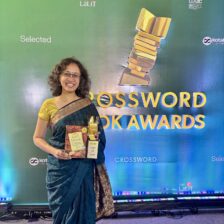Day three at AFCC 2022 was the whole reason I was there. Book launch day! Of course, that was the highlight of my day, so even though that did not technically come first, I’m going to begin with it.
Book Launch by Scholastic Asia

My book, Red Eyes, has been a long time in the making. I’ll write about the story behind the story (like I did for Dragonflies, Jigsaws and Seashells, The Clockwala’s Clues and Sisters at New Dawn) soon, but launching it at the Asian Festival of Children’s Content was such a delight! Equally delightful was listening to the other three authors talk about their books. I would love to read them all!
The book launch was a public event, so you can still watch it here.
Now, I’ll come back to everything I attended as a participant, and all that I took away from the festival.
When Comics Come to the Classroom

A few weeks ago, I organised a comic-making workshop for the children at my creative writing programme, and I was amazed that every single one of them managed to make a four-panel comic strip in an hour. Honestly, that was the main reason I attended this session on comic-making. The power of comics is huge! And teaching comics can be quite rewarding too.
We use comics in one form or another all the time. For instance, how many comics have you seen over the last couple of years telling you to wash your hands? For reluctant readers, comics are far more approachable, and even for adults, infographics often work better than dense text.
One important idea I took away from the session is the fact that if you’re not seeking to be a comic artist, i.e. if you are using comics as a trigger to express yourself, you really don’t need to draw at all! Take pictures of yourself and paste them, creating a comic of your own!
Publishers Discuss: Diversity and Inclusion in Books

I attended the presentation on diversity and inclusion synchronously, and I thoroughly enjoyed it. Among other things, Radhika Menon spoke about exposing children to diverse stories to make them aware that languages other than the ones they speak exist. Adivasi stories are important and are finally being translated and published. The inclusion of languages that children may not understand helps build awareness that there exist other realities.
Just like in so many other sessions I attended at the AFCC, Reni Roxas spoke about how much talking pictures do in picture books. In the context of inclusion, I loved the image she shared of the book Seven Slippers. Along with three pairs of slippers, there’s one singleton. And then, within the pages of the book, we see that the single slipper is accompanied by a crutch. All the text says is Lonely slipper, come join us!
Lighten Up with Laughter: A Serious Look at the Genre of Humour

This was one of the most enjoyable sessions of AFCC 2022! Of course, it is unsurprising that so many people have studied humour, but I was amazed at the number of theories as to how humour is created – the superiority theory, cautionary tales, the incongruity theory, irony, the concept of the carnival, benign violation … And the speakers explained each of these ideas with examples. It was eye-opening!
Although I did attend other sessions on day three, I didn’t find them as engaging. I also know that the magic of a lit fest fades as days go by, so I’m not as enthusiastic about watching recorded sessions as I am about attending them live. I didn’t attend much on day four, so that’s all: AFCC 2022 was a two-week long lit fest for me!

Leave a Reply